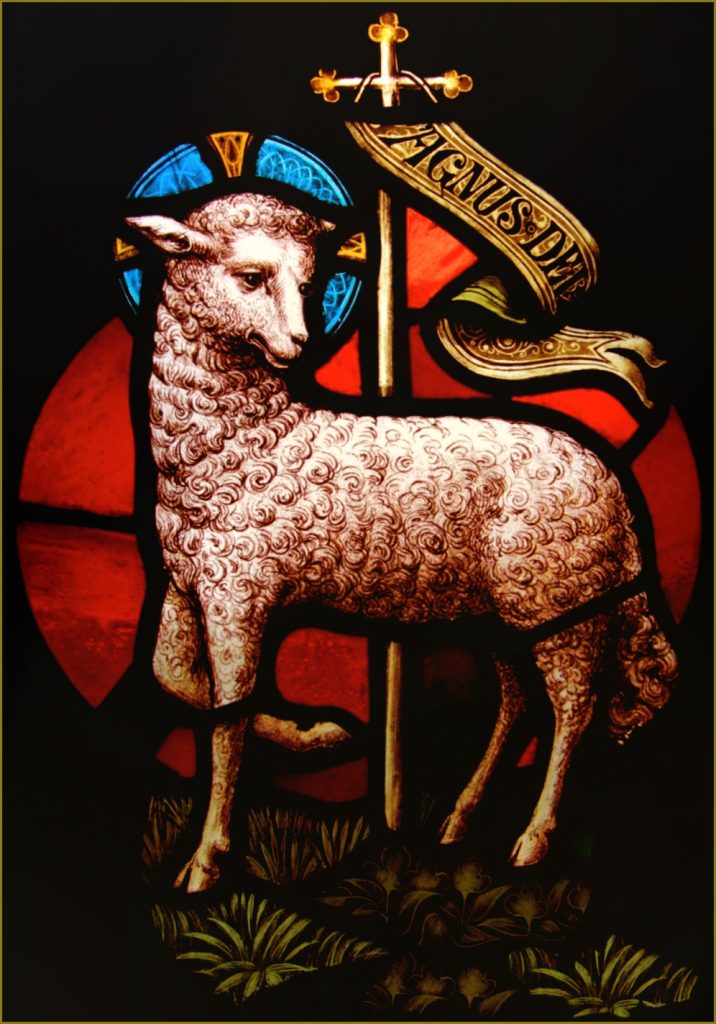or the Agnus Dei
that is the opening prayer of the day

The Lamb of God who takes away the sins of the world
Let’s try to understand individual parts of Holy Mass
When the priest breaks the Host, the faithful recite or sing the Agnus Dei: “Lamb of God, who takes away the sins of the world, have mercy on us… grant us peace.” This text contains almost verbatim the confession of John the Baptist during the baptism of Jesus in the Jordan River: “Behold the Lamb of God who takes away the sins of the world” (John 1:29); John confirms this to two disciples (cf. Jn 1:36). Jesus – the Lamb of God, is the One prefigured in the lamb eaten by the Israelites in Egypt and that opened the way to freedom for them (cf. Exodus 12); Jesus – the Lamb of God, is the One about whom the prophet Isaiah says that He is “led to the slaughter” (53:7); Jesus – the Lamb of God, is the One who, as God’s servant, offers sacrifice for all humanity (cf. Acts 8:26-39). Saint John the Evangelist speaks about the Lamb of God as many as 33 times in the Apocalypse, but already in the eschatological dimension, i.e., He, slain and at the same time reigning; He who opens the book of life, who is the light for the new city of Jerusalem and who will come at the end of the world (cf. 5:6, 9; 13:8; 21:1-27).
How did Agnus Dei find its place in the liturgy of the Holy Mass? This is due to Pope Sergius I (687–701). The circumstances of including this text in the Eucharistic rite were special. It was like this: the Byzantine Emperor Justinian II, residing in Constantinople, intended to limit the independence of the Roman Church by introducing Eastern customs. For this purpose, he convened the so-called Trullan Synod, which, among others, – as part of the dispute under the influence of Islam against the representation of Divine Persons and saints in paintings and sculptures – it forbade depicting Jesus Christ as a lamb. Pope Sergius did not sign this regulation because it was not in line with the faith of the Roman Church. The emperor ordered the Pope’s arrest and deportation to Constantinople, but the Roman people defended their spiritual father. The Pope decided to fight the emperor’s decree with prayer, introducing the text “Lamb of God” into the liturgy of the Holy Mass. Since the 11th century, the third invocation ends with the words “grant us peace.” This form was also adopted by Pope Paul VI as part of the liturgical reform of the Second Vatican Council.
Let’s discover the theological meaning and spiritual depth of Agnus Dei. Prayers in the liturgy of the Holy Mass are usually addressed to God the Father through Jesus Christ. The exceptions are the Kyrie and Agnus Dei, because in them we turn directly to Jesus Christ. The “Lamb of God” accompanies, as already mentioned, the breaking of the Bread. This rite takes us to the cross where Jesus Christ, the Lamb of God, dies. This is how the famous Austrian liturgist J. A. Jungmann prayed to Him. “You are Christ-God, whose side was pierced on Golgotha in Jerusalem. You are the Lamb of God who takes away the sins of the world” (Missarum Sollemnia, 2:373). The bread that is broken has the Latin name hostia, which also means sacrificial animal. Previously, in the Eastern liturgy, the bread intended for consecration was called “lamb”. Christ himself is therefore the Lamb of God who gives His life for people, taking away their sins.
During His baptism in the Jordan River, John the Baptist sees Jesus among people whose sins He takes upon himself; He is baptized with them, that is, Jesus shows solidarity with all of them: with the weak and crippled, with sinners and those who go astray, with those who bear the burden of life and perhaps even stand on its ruins. That is all they bear – their cry of suffering too! – He bears it and goes to death on the cross. Jesus, the Lamb of God, lives the lives of these people, takes on their burdens and dies their deaths. Why? A beautiful and profound answer to this question is given by D. Bonhoeffer, a German Christian who, almost on the eve of the end of World War II, gave his life for faith and peace:
“Ecce homo . . .
look what a man!
In Him the world is reconciled with God.
Not by destruction,
but by reconciliation the world was conquered.
Not ideals, or programmes
not conscience, duty, responsibility, virtue,
but only God’s perfect love could
meet reality and overcome it.
This divine love does not withdraw from reality
and does not hide in noble souls detached from the world,
but he experiences a harsh reality and suffers in it
in a cruel way…
The world went crazy in the body of Christ.
This is how reconciliation takes place.
Ecce homo!”
This is how our reconciliation happened and is still happening! We need to break away from the pace of life, stop at the cross and call out to the Lamb of God: “Praised be You who take away sins and grant peace!”
Prayer of Saint Father Pio (after Holy Communion):
“Stay with me, Lord, because I need Your presence so as not to forget You. You know how easily I leave You. Stay with me, Lord, for I am weak. I need your strength not to fall […]. Stay with me, Lord, because only You are my light. Show me Your will, so that I may hear Your voice and follow it […]. Yes, Lord, please stay with me, because I am looking for You alone, Your love, Your grace, Your Spirit. I love You and I ask for only one reward, that I may love You more and more” (Adoration, pp. 41-42).